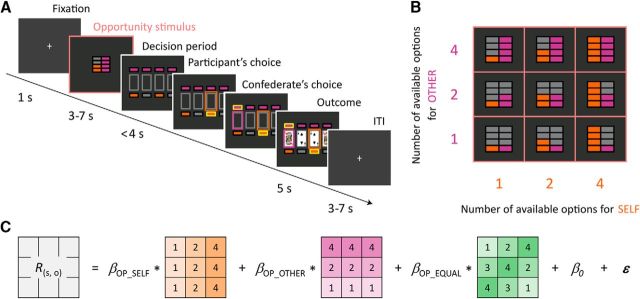Figure 1.
Two-person choice task. A, A trial started with the presentation of an “opportunity stimulus” that indicated the number of choice options available to a participant (SELF) and confederate (OTHER). During the subsequent decision period, each player chose one of the options available to them (the confederate's choice was actually determined by computer). The reward outcomes of their choices were indicated by cards (a face card was associated with monetary rewards whereas a deuce was associated with no reward). In the example shown in the figure, there are two options available to the participant, and four to the confederate. Upon choice, the participant's chosen option is highlighted, followed by the revealed choice of the confederate, followed by simultaneous showing of both of their outcomes (“no reward” for the participant and “reward” for the confederate in this case). B, Opportunity-stimulus conditions. The numbers of choice options for SELF and OTHER were manipulated independently. C, The regression model used to analyze the neural responses to the opportunity stimuli. The 3 × 3 matrices represent the nine opportunity-stimulus conditions shown in B. The same model was also used to analyze subjective emotional pleasantness (Fig. 2B). The β coefficients indicate how the dependent variables (R(s, o): the neural responses or subjective emotional pleasantness) of an individual are sensitive to (1) the number of available options for the participant (βOP_SELF), (2) those for the confederate (βOP_OTHER), and (3) the “choice equality” or the degree of equality in the numbers of available options between the two players (βOP_EQUAL), quantified using the absolute value of their difference.

